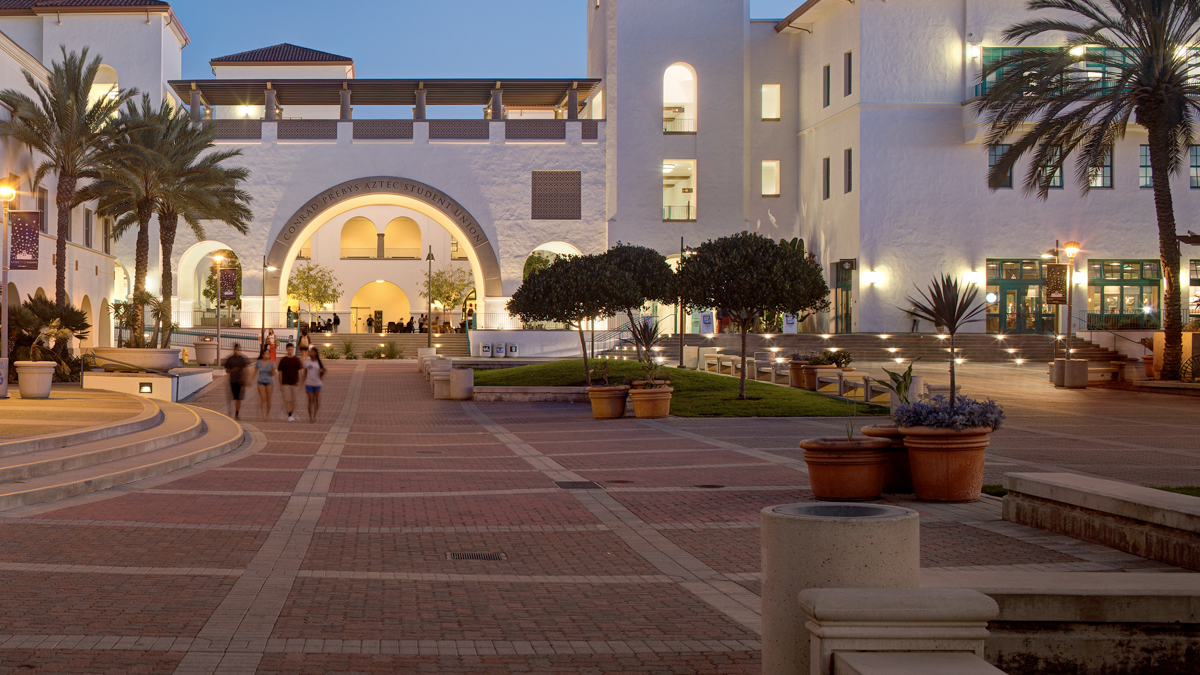American Sign Language program flourishes in DLE department

In March, a nationally-known comedian took to the stage at San Diego State University’s Montezuma Hall. But this was no run-of-the-mill set.
The headliner in question was Harold Foxx, a comic who proudly identifies as Deaf. Signing in American Sign Language (ASL), he riffed on everything from Deaf Black culture to his favorite barbecue.
The event was called ASL BAM, a collaboration between the ASL program and the Aztec ASL Club student organization. While there were plenty of laughs, ASL lecturer Brad Cohen considers it all very much “part of the education” into the primary language of about half a million people in the U.S.
“When students show up to this, it brings a whole different perspective,” he said. “We want to help them really understand that Deaf people have real life experiences — and help them to see those experiences.”
Indeed, the smiling faces in a nearly-packed room at ASL BAM underscored a larger truth — ASL at SDSU seems to be having a moment.
Since moving to the College of Education nearly a decade ago, course offerings and faculty members in the program multiplied in number. And more significant growth may soon be in the offing.
From the beginning
SDSU first began offering ASL classes in the 1970s, and in the 2000s robust instruction was available through the School of Speech, Language, and Hearing Sciences. However by 2010, budget cuts caused by the Great Recession reduced course offerings from 19 to just one.
For the rest of the decade, members of the Aztec ASL Club and others fought tirelessly to reinstate courses for general education students. Ultimately, a change of scenery made that goal a reality.
In 2016, the ASL program moved to COE’s Department of Dual Language and English Learner Education (DLE) — a department that produces bilingual educators for California’s linguistically-diverse classrooms. Current DLE chair Professor Sera J. Hernández hails the pairing as a perfect philosophical fit.
“DLE’s commitment to improving educational practices for linguistically- and culturally-diverse students makes it a natural home for the ASL program,” Hernández said. “The department is committed to normalizing bilingual language practices in schools and in the larger society. Relatedly, the bilingual practices of ASL users from the Deaf community — ASL and written English — should also be normalized and elevated.
“Reframing deafness as an asset and not an impairment is part of this work. This is similar to DLE’s historical and current efforts on reframing immigrant students’ home languages as a resource for learning in schools and not as an obstacle to overcome.”
The growth of ASL under the DLE umbrella has been remarkable.
In 2016, the program had one faculty member — lecturer Janette Dorricott — teaching three level-one courses. In the decade since, the program has added Level 2, 3 and 4 courses and four additional lecturers, Cohen, Garrett Bose, Svenna Pedersen and Adam Frost. All five of SDSU’s ASL faculty members proudly identify as Deaf.
The expansion was driven by strong interest from the SDSU student body.
Bose, who serves as program coordinator, says that students are drawn to the program for multiple reasons. Some students take ASL courses because they are speech majors. Some wish to communicate better with the Deaf community. And others assume — incorrectly — that ASL is easy.
“A lot of students assume American Sign Language is signing in exact English, but it isn’t,” explains Bose. “But even when they find out that’s not true, long-term, they stick around. I observe that’s because the faculty make them feel like they're able to continue by providing encouragement and motivation.
“When they start learning to sign, it seems they start feeling good. And I think that working with Deaf people helps."
Future growth
The ASL program at SDSU may soon take another momentous step. A new minor is currently pending approval and there are hopes to one day launch an ASL major.
Bose said a minor would be beneficial for students interested in careers in speech therapy or in positions where communicating with the Deaf community is essential. A bachelor’s degree program, which would be the first of its kind in San Diego, would prepare students to become ASL interpreters.
“I think the main impact would be for the Deaf community and communication access,” Cohen said. “I think offering a major would be fantastic. We have a high demand for interpreters — there just aren’t enough available.”
In the meantime, the ASL program and Aztec ASL Club continue to offer the SDSU community a gateway to exploring Deaf culture.
ASL BAM was launched in 2016 and three years later, event turnout nearly reached 1,000 attendees. After a hiatus because of the COVID-19 pandemic, ASL BAM returned in full force this year with Foxx’s performance — and, again, it wasn’t just for laughs.
“It has a huge impact on students in terms of how they view Deaf people,” Cohen said. “They see this and say, ‘Wow, there is a culture there! “It really affects their perspective on that — and it’s really awesome to see.”
Learn more by following the SDSU ASL program and Aztec ASL Club on Instagram.

